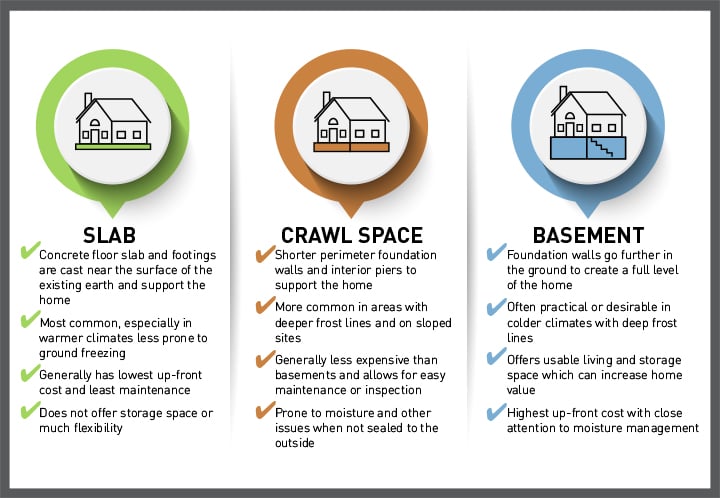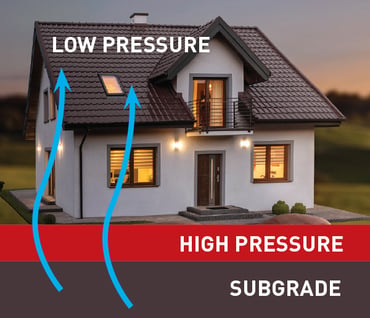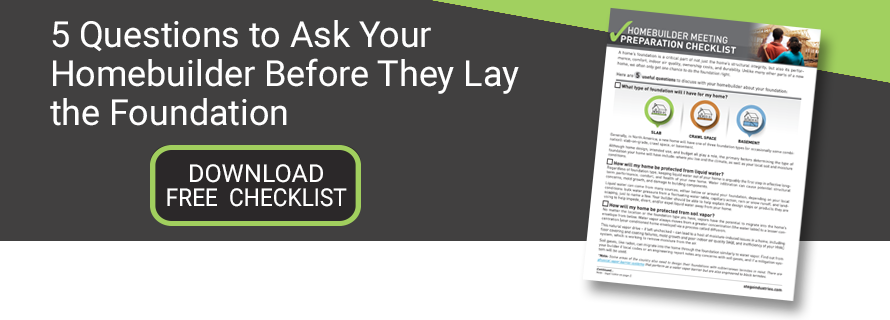5 Questions You MUST Ask Your Homebuilder About Your Foundation
A Better Understanding of Your Home’s Foundation Can Ensure a Dry, Healthy, and Comfortable Living Space for Years to Come
Building a new home is full of excitement and anticipation. But it can be unfamiliar and overwhelming to homeowners, requiring a wide-ranging understanding of what it takes to build a home: the steps, the product selection, the scheduling, and more.
The good news for homeowners is that any experienced homebuilder will walk with you through the design and construction process.
Recently, homeowners are looking to better understand and be more involved in the construction of their new home, regardless of whether they are working with a large national or local custom builder. The prospective homeowner is better connected and has greater access to digital information than ever before. After all, building a new home will be one of the biggest investments of their lives; better knowledge of what goes into the construction of their new home can go a long way in providing peace of mind, pride of ownership, and useful familiarity for the long-term care of the home.
Although there are many components in the design and construction of a new home, the first side – its foundation– is a critical part of not just the home’s structural integrity, but also its performance, comfort, indoor air quality, ownership costs, and durability.
The foundation may not be as exciting as picking countertops or appliances, but it serves more than just supporting the load of the entire structure. Since the foundation sits on or below the soil, it also serves an important role in isolating the home from moisture, pests, and soil gases.
The bottom line: a good foundation starts with its structural strength, but its design should keep your home dry, healthy, and comfortable.
Unlike many other parts of a new home, we often only get one chance to do the foundation right, so here are some useful questions to discuss with your homebuilder about your home’s foundation to address these many key considerations.
#1 What type of foundation will I have for my home?
Generally, in North America, a new home will have one of three foundation types (or occasionally some combination):
- Slab-on-Grade
- Crawl Space
- Basement

Although home design, intended use, and budget all play a role, the primary factors determining the type of foundation your home will have include: where you live and the climate, as well as your local soil and moisture conditions.
For example, the depth of the frost (or freeze) line is often an important component in foundation design. The frost line is the depth in the ground where water in the soil is expected to freeze during cold times of the year. Freeze and thaw cycles lead to expansion and contraction of soil, which can cause shifting, cracking, and other structural concerns in the foundation. Thus, code requires footings to be located below the frost line.
In addition to local code information, a geotechnical report will provide useful soil data for the engineers you or the builder are working with to help make appropriate design decisions for your home’s foundation.
Generally, the frost line goes deeper in the ground as you move into colder climates. In warmer southern U.S. states, it doesn’t take much digging to go below the frost line. It’s much more common to find slabs-on-grade in these states, where the concrete floor slab and footings are cast near the surface of the existing earth and support the home. Slabs-on-grade usually have the lowest up-front cost, but don’t offer any storage or flexibility.
On the other hand, as we move north in the U.S., slabs-on-grade become less viable, as frost lines move lower. You’re more likely to see crawl spaces or basements as you often need to dig further to start the home’s foundation.
Crawl spaces are exactly what they sound like: an enclosed gap between the exposed ground and home’s floor that allows someone to access without standing up. Crawl spaces have shorter (think 2 to 4’) perimeter foundation walls and interior piers to support the home. Crawl spaces can allow room to locate HVAC and other utility equipment, but problems can begin to arise when the outside environment is not closed off from crawl spaces.
As the frost line deepens in even colder climates, basements become more practical and desirable. This is where the foundation wall goes further down in the ground (usually 7 or 8’) to create a usable level of the home. The extra space of a basement is a key benefit but going deeper in the ground with your foundation does mean careful attention to things like moisture management -- the first key considerations after a foundation’s strength.
#2 How will my home be protected from liquid water?
Regardless of foundation type, keeping liquid water out of your home is arguably the first step in effective long-term performance, comfort, and health of your new home. Water infiltration can cause potential structural concerns, mold growth, and damage to building components.
Liquid water can come from many sources, either below or around your foundation, depending on your local conditions: bulk water pressure from a fluctuating water table, capillary action, rain or snow runoff, and landscaping, just to name a few. Your builder should be able to help explain the design steps or products they are using to help impede, divert, and/or expel liquid water away from your home.
Capillary breaks, for example, may simply be a layer of compacted crushed rock that open free space below your slab-on-grade to stop the upward movement of liquid water against gravity, which is caused by adhesion or cohesion in some soils.
For below-grade foundation walls in basements or crawl spaces, passive approaches to the exterior, like waterproofing membranes, damp proofing, drainage mats, and footing drains, are ways to impede and convey water away.
Every area has minimum building code requirements but ask your builder to explain the solutions they rely on for effective liquid water protection. As a homeowner, keep in mind proper grading around the home and how to avoid introducing unwanted water over time, like from landscaping.
In areas where sub-soil bulk liquid water is more of concern, builders may use a sump pump. This connects to a collection drain installed beneath a basement floor slab or in a crawl space, expelling liquid water that has collected under and around the foundation. If you have ever had a sump pump in your home, you know they require more active attention and maintenance from a homeowner over time.
#3 How will my home be protected from soil vapor?
No matter the location nor the foundation type you have, vapors have the potential to migrate into the home’s envelope from below. Water vapor always moves from a greater concentration (the water table) to a lesser concentration (your conditioned home envelope) via a process called diffusion. 
This natural vapor drive -- if left unchecked -- can lead to a host of moisture-induced issues in a home, including floor covering and coating failures, mold growth and poor indoor air quality (IAQ), and inefficiency of your HVAC system, which works by removing moisture from the air.
Many prospective homeowners (and even some homebuilders) don’t realize the key distinction between the behavior of water vapor and liquid water. Protecting against water vapor diffusion is entirely different from the steps above, which deal with liquid water. Things like capillary breaks will not do anything to stop the diffusion of water vapor. And in basements and slab-on-grade homes, most people don’t consider that concrete itself, although seemingly dense and dry, is not vaporproof.
Because of this, you will want to ask your homebuilder how they plan to stop the diffusion of water vapor beneath your home.
The most common and effective solution is the use of a water vapor barrier (or retarder) beneath the home’s concrete slab or used to cover the exposed earth in a crawl space. These membranes are engineered plastic sheets that come in rolls with system accessories for effective and efficient installations.
To meet industry requirements and best practices today, not just any plastic can serve as an effective water vapor barrier or retarder. Below-slab and crawl space vapor barriers perform far better than generic, low-quality, 6-mil poly sheeting (often called Visqueen) to provide necessary levels of vapor protection, strength, and longevity.
Additionally, many homes may also be built on soil with dangerous gases like radon. Soil gases, like water vapor, typically move from higher to lower concentrations and can migrate into the home’s living space through the foundation.
To protect new homes from radon, permeable layers and venting systems are typically used with an effective vapor barrier to not only impede soil gas movement but expel it away from the home. Find out from your builder if your local codes or engineering report notes any concerns with soil gases, and if a mitigation system will be used.
*Note: some areas of the country also need to design their foundations with subterranean termites in mind. There are physical vapor barrier systems that perform as a water vapor barrier but are also engineered to block termites.
#4 What about comfort and efficiency?
New homeowners will probably think about the comfort and efficiency of their home as a top-down equation: solar panels, air conditioning, and insulation get a lot of attention in this realm. But maximizing the comfort and efficiency of your home, however, is really a bottom-up process.
When we locate foundations below-grade, we have colder temperatures to contend with. No one wants to spend time in an uncomfortably cold basement or walk on chilly or drafty floors. This also increases the load on a home’s HVAC system to maintain comfortable interior temperatures.
Foundation insulation, installed at construction, can play an important role in the comfort and efficiency of the home. Although not required in all climate zones, it can have benefits in all areas and with all foundation types. It will help maintain comfortable temperatures and help keep concrete foundation elements warmer.
Making sure your home is well air-sealed is also a key contributor to its efficiency. For crawl spaces and basements with foundation walls, proper air sealing at the wall to framing intersection and at rim joists can have a big impact.
Your builder should be able to discuss insulation strategies and options based on your foundation type and climate, and how they plan to air seal at the home’s foundation.
#5 What products do you use?
Product choices can make a significant difference in new home construction. What is used at the home’s foundation is particularly crucial for long-term performance, since this is a part of your home that you:
1) can’t replace easily and
2) won’t want to deal with costly problems in the future.
Your builder will have some tried-and-true foundation systems and products they use. Ask them to show them to you and explain how they plan to use them. You might also ask them what types of warranties come with the products they use, or even if they have a home buyer warranty package that includes the home’s foundation. .png?width=984&name=Blog%20Article%20Collage%20Template%20(2).png)
There is a wealth of information out there about building materials and their performance. Depending on how you and your builder are collaborating on your new home build, don’t be shy about bringing product and system choices to the table.
The construction of the foundation is an exciting milestone in a new home build. We hope this article helps give you a better understanding of the foundation of your home and spurs useful discussion with your builder to help contribute to peace of mind that your home will be dry, healthy, and comfortable for years to come.

Written by Tom Marks
Tom Marks is the Business Development Project Manager with Stego Industries, LLC. He has been with Stego since 2007, serving many years as the Rocky Mountains Regional Manager. Now, his focus is geared toward vapor barrier solutions for new and existing homes as the Product Manager of the StegoHome and StegoCrawl brands. In addition, Tom serves as Sustainability Manager, overseeing Stego’s leadership in holistic product and corporate sustainability. Tom enjoys working with a wide range of project team members and customers to incorporate effective sub-slab vapor protection and create healthy, sustainable homes and buildings.
- Stego (26)
- StegoCrawl (24)
- Stego-Awareness (17)
- StegoHome (15)
- Case Studies (14)
- StegoCrawl-Consideration (12)
- StegoCrawl-Awareness (11)
- Customer Stories (9)
- Stego-Consideration (9)
- Pango (8)
- StegoHome-Consideration (8)
- Beast (7)
- How to Install (7)
- StegoHome-Awareness (7)
- Drago (5)
- Pango-Awareness (5)
- Beast-Awareness (4)
- Beast-Consideration (3)
- Drago-Awareness (3)
- Pango-Consideration (3)
- Stego IQ (3)
- Drago-Consideration (2)
- StegoCrawl-Decision (2)
Popular Posts
Stay Connected.
Enter your email below.








Post Comments